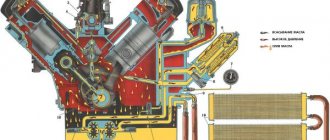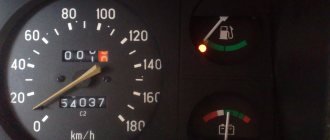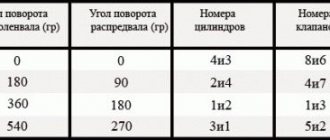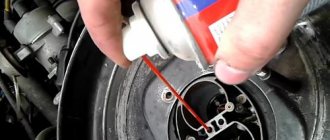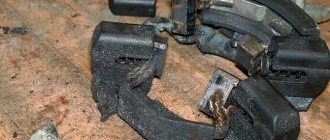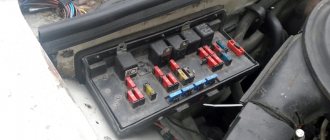The “sevens”, like most modern cars, use a single-wire circuit for supplying electricity to electrical equipment. The other terminal of the consumer is always connected to the ground of the machine to which the negative terminal of the battery is connected. This solution allows not only to simplify the design of the on-board network, but also to slow down corrosion.
VAZ-2107 diagram: first option
Full size wiring diagram:
Varieties
Tachometers produced on the market differ from each other in design and method:
- installations and connections;
- operating principle.
Also, special devices are produced for injection and carburetor engines - they are not interchangeable. For the VAZ-2105, a remote device is usually selected, since there is no room for a standard one in the panel of this car.
There are also non-contact varieties of tachometers. They don't need any connection at all. You just need to understand that these devices are used rather as diagnostic equipment that helps check the engine and adjust it. That is, they are not used in the mode of permanent recording of readings.
For those wishing to install a standard device, we recommend that you first replace the original dashboard with the one designed for the VAZ-2107 model. This shield has a socket, which means installing a tachometer on the 2105 will not cause any difficulties.
The remote type is placed in any convenient place - it comes with a special support leg. Instead, it is permissible to use double-sided tape. The cheapest option is the standard ones.
Electrical diagram VAZ-2107 carburetor
Electrical diagram of VAZ 2107, 21074 produced in 1988-2001 with generator 37.3701
- block headlights
- side direction indicators
- accumulator battery
- starter relay
- carburetor electro-pneumatic valve
- carburetor microswitch
- generator 37.3701
- gearmotors for headlight cleaners *
- Fan motor switch sensor
- engine cooling fan motor
- sound signals
- distributor
- spark plug
- starter
- coolant temperature gauge sensor
- engine compartment lamp
- low oil pressure warning sensor
- low brake fluid level indicator sensor
- windshield wiper motor
- carburetor electro-pneumatic valve control unit
- ignition coil
- headlight washer pump motor *
- windshield washer pump motor
- mounting block
- windshield wiper relay
- hazard warning and direction indicator relay
- brake light switch
- reverse light switch
- ignition relay
- ignition switch
- three lever switch
- hazard switch
- socket for portable lamp**
- heater fan switch
- additional resistor for the electric motor of the heater (stove)
- rear window heating indicator lamp
- low brake fluid level warning lamp
- signaling unit
- heater fan electric motor
- glove compartment lamp
- light switches on the front door pillars
- switches for warning lights of open front doors ***
- front door open warning lights ***
- connection block
- cigarette lighter
- watch
- instrument light switch
- diode for checking the serviceability of the low brake fluid level indicator lamp
- fuel level indicator
- fuel reserve indicator lamp
- speedometer
- turn signal indicator lamp
- carburetor choke indicator lamp
- battery charge indicator lamp
- carburetor choke warning switch
- instrument cluster
- econometrician
- light switches on the rear door pillars
- coolant temperature gauge
- tachometer
- parking brake indicator lamp ("handbrake")
- low oil pressure warning lamp
- high beam indicator lamp
- indicator lamp for turning on external lighting
- voltmeter
- parking brake indicator switch ("handbrake")
- outdoor light switch
- rear window heating switch with backlight
- rear fog light switch with on/off indicator *
- fog light circuit fuse
- lampshade ****
- tail lights
- level indicator and fuel reserve sensor
- connectors for connecting to the rear window heating element *
- license plate lights 2107
Wiring diagram VAZ-2107 carburetor - full view:
Failure of the main vehicle systems
The reason for the sudden failure of many components of the VAZ 2107 car may be damage and failure of electrical wiring elements.
The most common wiring failures are listed below:
- A common defect is a blown fuse link caused by a circuit overload or short circuit. Since the electrical circuit of the VAZ 2107 often uses old-style fuses, oxidation or loosening of the contact clamps in the mounting block often occurs. To correct these faults, replace the fuse or clean the contacts. The latest car releases used mounting blocks with blade fuses, which provide better contact and more reliable operation of the electrical circuit.
- A more complex case is the burning or oxidation of conductive tracks in the mounting block. To repair, the unit is removed from the car, the damaged areas are soldered and covered with protective varnish. In case of critical damage, the unit must be replaced.
- When a section of the wiring is short-circuited, the fuse-link will constantly burn out. To find a damaged element, you need to test the circuit with a multimeter. Replaced wires should be carefully laid along the standard route. An open circuit is also determined by the continuity of the wires.
- If there is a problem with the components of the injection system, the Check Engine indicator light on the instrument cluster may turn on. The cause may be sensor failure or broken circuits. To find the causes of damage, you should diagnose the injection system using a test device connected to the diagnostic connector. The error codes available in the system can be deciphered and repairs are made based on this data.
- The cause of complete inoperability of the electrical system may be a discharged battery or oxidation of the negative wire that is connected to the body. A low battery is indicated by a dim glow of the control lamps and their complete shutdown when a load is connected (horn or an attempt to crank the engine with the starter).
- A burning battery charging lamp with the engine running indicates a malfunction of the generator or an open circuit connecting the generator to the battery.
- Light pulsations when the engine is running are a symptom of a burnt-out control relay on the generator. The relay must be replaced, since operating the vehicle with increased voltage in the on-board network is unacceptable.
The video provided by the Avtoelektrika HF channel shows the repair of the wiring of the reversing lights on a VAZ 2107.
Mounting block connection diagram
P1 — relay for turning on the heated rear window; P2 - relay for turning on the headlight cleaners and washer; P3 - relay for turning on sound signals; P4 - relay for switching on the electric motor of the engine cooling system fan; P5 - headlight high beam relay; P6 - low beam headlight relay; A - the order of conditional numbering of plugs in the mounting block blocks. The outer number with the letter “Ш” in the plug designation is the block number, and the inner number is the conventional number of the plug.
↑ Scheme for switching on direction indicators and hazard warning lights with a breaker relay
1 — block headlights with front direction indicators; 2 — side direction indicators; 3 — mounting block; 4 - ignition relay; 5 — ignition switch; 6 — relay-interrupter for direction indicators and hazard warning lights; 7 - turn signal indicator lamp located in the speedometer; 8 — rear lights with direction indicator lamps; 9 — alarm switch; 10 — direction indicator switch in a three-lever switch;
- A - to terminal “30” of the generator;
- B - numbering of plugs in the hazard warning switch;
- B - the order of conditional numbering of plugs in the relay-interrupter of direction indicators and hazard warning lights.
Relay-interrupter 6 is designed to receive an intermittent light signal from the direction indicators both in the emergency mode and in the turn indication mode, as well as to monitor the serviceability of the direction indicator lamps. If the lamps are working properly, then in the turn indication mode it causes warning lamp 7 to blink at the usual frequency. If the lamps are faulty (burnout or break in the lamp circuit), then the breaker relay ensures that the control lamp blinks twice as fast.
The breaker relay is mounted under the instrument panel on a bolt welded to the wall of the air supply box. A faulty breaker relay cannot be repaired and should be replaced with a new one.
The breaker relay must ensure blinking of the direction indicator lamps with a frequency of 90±30 cycles per minute at a rated load of 92 W, an ambient temperature of –20 to +50°C and a voltage of 10.8 to 15 V.
Until 1985, the 23.3747 relay-interrupter, assembled on integrated circuits, was used. It created a constant lighting of the control lamp in the event of any of the turn signal lamps burning out or an open circuit in its power supply.
Since 1985, a relay-interrupter 231.3747, made of discrete elements, has been installed.
The characteristics of both relay interrupters are the same. The only external difference is that relay-interrupter 231.3747 does not have plug “5”. The supply voltage is supplied only to plug “1”. Therefore, there is no need for the brown wire that previously connected plug “5” of the breaker relay with plug “6” of the alarm switch 9.
In 1995, the hazard warning switch was slightly modified. His terminals “5” and “6” were eliminated, as well as the connection diagram of the control light inside the switch was changed.
Schemes of individual blocks of the seven
Power supply system
Power plant starting system
1 - starter; 2 - relay; 3 — ignition switch; 4 - battery
Ignition system
1 - generator; 2 — ignition switch; 3 - distributor; 4 - breaker; 5 — candles; 6 - coil; 7 - battery
Contactless ignition system
External and internal lighting
Windshield wipers and washers
1 — electric motors of the windshield wiper; 2 — washer motor; 3 — mounting block; 4 — ignition switch; 5 - washer switch
Cooling Fan
1 — fan electric motor; 2 - sensor; 3 — mounting block; 4 - ignition relay; 5 - ignition switch.
Description of the scheme
Electrical equipment is represented by a large number of elements that can be combined into the following systems:
- power system (battery and generator);
- engine starting system (starter and ignition);
- ignition system (coil, distributor and spark plugs);
- interior and road lighting system, alarm system (headlights, lights and relays);
- various control devices;
- other devices (windshield wiper, washers, cigarette lighter, sound signals, etc.).
The operation of all systems is controlled by switches and relays, and electricity to devices most often comes through the ignition. The cigarette lighter circuits, horns, brake lights and hazard lights are always on.
The electrical circuit of the VAZ 2107 car includes a circuit for connecting devices, which is single-wire, which makes installation easier and reduces the number of wires.
Wires for connecting electrical appliances
| Connection type | Section, mm2 | Insulation color |
| Negative terminal of the battery - vehicle ground (body, engine) | 16 | Black |
| Starter positive terminal - battery | 16 | Red |
| Positive contact of the generator - plus battery | 6 | Black |
| Generator - black connector | 6 | Black |
| Terminal on the generator “30” – white MB block | 4 | Pink |
| Starter connector “50” – starter relay | 4 | Red |
| Starter Start Relay - Black Connector | 4 | Brown |
| Ignition switch relay - black connector | 4 | Blue |
| Ignition switch output “50” – blue connector | 4 | Red |
| Ignition switch connector “30” – green connector | 4 | Pink |
| Right headlight plug - ground | 2,5 | Black |
| Left headlight plug - blue connector | 2,5 | Green, gray |
| Generator output “15” – yellow connector | 2,5 | Orange |
| Right headlight connector - ground | 2,5 | Black |
| Left headlight connector - white connector | 2,5 | Green |
| Radiator fan - ground | 2,5 | Black |
| Radiator Fan - Red Connector | 2,5 | Blue |
| Ignition switch output “30/1” – ignition switch relay | 2,5 | Brown |
| Ignition switch contact “15” – single-pin connector | 2,5 | Blue |
| Right headlight - black connector | 2,5 | Grey |
| Ignition switch connector “INT” – black connector | 2,5 | Black |
| Six-pin block of the steering column switch - “ground” | 2,5 | Black |
| Two-pin block of the steering column switch - glove box illumination lamp | 1,5 | Black |
| Glove compartment light - cigarette lighter | 1,5 | Black |
| Cigarette lighter - blue block connector | 1,5 | Blue, red |
| Rear window defroster - white connector | 1,5 | Grey |
Useful: Connection diagram for generator in VAZ cars
Carburetor engine
The operation of an engine with a carburetor has a classic scheme:
- When the ignition key is turned to the "Starter" position, the electronic system supplies power to it.
- The generator starts working.
- The generator transmits electric current to the coil. It is used to produce high-voltage currents. Low voltage currents are supplied to the coil. Passing through the module, they are transformed into high-voltage ones and transmitted via a high-voltage wire to the distributor.
- Using high-voltage currents, the distributor drive rotates the crankshaft of the power unit. He closes the contacts in order of priority and delivers an electric discharge to the spark plugs.
The principle of operation is reflected in the electrical circuit of an engine with a carburetor.
Classic wiring diagram - carburetor
Classic ignition
The contact system includes the following elements:
- switch;
- coil;
- distributor;
- high voltage wires;
- candles.
Thanks to the distributor, the circuit of the primary winding of the ignition module is interrupted, and then the high-voltage current is distributed in the required sequence to the spark plugs. With the help of a coil, low voltage current is converted into high voltage current. The spark plugs ignite the fuel mixture in the engine cylinders.
Classic ignition system
If the engine does not start when you turn the ignition key, the reason may be as follows:
- An open circuit between the generator and the coil. In this case, you need to check all contacts and the integrity of the electrical wiring.
- The coil is faulty. It can be checked using a spark: remove the wire from the distributor and touch the metal part. If a spark appears during operation of the power unit, it means the module is working.
- A break in the electrical circuit between the distributor and the spark plugs. In this case, you need to check inside the distributor cover, the slider located there, and the high voltage wiring connecting the distributor cover to the spark plugs.
This is interesting: Anti-rain: top 5 best products
After identifying and eliminating a malfunction in the carburetor, the engine should start without problems if the other components of the car are working properly.
Electronic ignition
Some VAZ 2107 models that were produced after 1987 had a contactless ignition system installed. Although the car was more expensive, it was in demand. The innovation was that an electronic switch was installed between the distributor and the coil.
The contactless ignition system includes:
- switch;
- ignition switch;
- coil;
- distributor sensor;
- high voltage wires;
- candles.
Contactless ignition system
Using the distributor sensor, control signals are transmitted to the switch to generate a spark and high-voltage current pulses are distributed across the spark plugs. The function of the switch is to convert control pulses from the contactless sensor into a pulse current that is supplied to the primary winding of the coil. Thus, it improves spark formation if the engine runs on a lean fuel mixture.
The switch is tested with a spark. If during testing the distributor does not receive a high voltage pulse, it means that the switch is faulty and requires replacement.
If after replacing the switch with a new one the problem remains, then it is necessary to replace the electrical wiring on the VAZ 2107. Most likely, the reason lies in the high resistance of the wiring cores, this entails a weak spark formation.
Car wiring diagram
1 – radiator fan drive motor; 2 – relay and fuse block (mounting block); idle speed sensor; 4 – engine control unit; 5 – potentiometer; 6 – set of spark plugs; 7 – ignition control unit; 8 – electronic crankshaft sensor; 9 – electric fuel pump; 10 – tachometer 2107; 11 – lamp for monitoring the health of electronic systems; 12 – ignition system control relay; 13 – speed sensor; 14 – diagnostic connector; 15 – set of injectors; 16 – adsorber solenoid valve; 17, 18, 19 – fuse block protecting the injection system circuits; 21 – electronic fuel pump control relay; 22 – electronic relay for controlling the intake pipe heating system; 23 – intake pipe heating system; 24 – fuse protecting the heater circuit; 25 – electronic oxygen level sensor; 26 – cooling system temperature control sensor; 27 – electronic air damper sensor; 28 – air temperature sensor; 29 – pressure control sensor.
Advantages of the VAZ 2107 with an injection system
- The fuel-injected "seven" starts moving more confidently. Due to the fact that the electronics quickly respond to changes in the gas pedal and engine operating mode, the chances of stalling at start (even at idle) are reduced.
- Simplified cold engine starting. The mixture composition is controlled automatically, taking into account the engine temperature. There is no need to manually control the mixture composition using the air damper.
- Reduced time required for warming up. Thanks to automatic optimization of the mixture composition, running a cold engine does not cause any difficulties. When driving, there are no jerks and dips characteristic of a cold carburetor engine.
- Simplifying ignition system maintenance. There is no need to adjust the gap of the breaker contacts and check their condition.
- Greater engine power and efficiency thanks to the optimal gasoline-air mixture ratio in all operating modes.
Fuse and relay diagram 2107
On newer “sevens” a block with 17 fuses and 6 relays is installed. VAZ 2107 fuses on the “new” unit protect the following electrical circuits and devices:
- Reversing lamps, heater fan, rear window defroster warning lamp and relay, rear wiper motor and rear washer pump.
- Electric motor for front wipers.
- Reserve socket.
- Reserve socket.
- Power supply for heated rear window.
- Clock, cigarette lighter, power socket “carrying”.
- Signal and radiator fan.
- Turn signal lamps in emergency mode.
- “Fog lights” and a relay that regulates the voltage of the on-board network.
- Instrument panel lamps.
- Brake light bulbs.
- Right high beam headlight.
- Left high beam headlight, high beam warning lamp.
- Side lights (rear right, front left), license plate and engine compartment lighting.
- Side lights (rear left, front right), glove compartment and cigarette lighter lamps.
- Low beam (right lamp).
- Low beam (left lamp).
The block relays perform the following functions:
- Heated rear window relay.
- Headlight cleaner and washer relay.
- Signal relay.
- Cooling system electric fan relay.
- High beam relay.
- Low beam relay.
The fuse block of the VAZ 2107 (injector) is no different from the block on the carburetor “seven”. Injection models are simply equipped with an additional relay and fuse box installed in the cabin under the glove compartment. The block includes three relays - the “main” relay, the fuel pump relay and the fan relay.
Wiring diagram to help owners of the seventh VAZ model
The quality of its operation depends on the serviceability of the components and systems of the vehicle. Modern cars are packed with electronics, so the electrical system requires a lot of attention. The article examines the electrical circuit of the VAZ 2107 car, signs of a malfunction, and also discusses the features of carburetor engines and those with an injector.
Wiring diagram VAZ 2107
Modifications of the VAZ-2107 car
VAZ-2107 . Basic version of the sedan, with an 8-valve carburetor VAZ-2103 engine, 1.5 liters.
VAZ-2107-20 . The same VAZ-2107, but with a 1.5-liter VAZ-2104 injection engine that meets the Euro-2 environmental standard.
VAZ-2107-71 . The car for the Chinese market was equipped with a VAZ-21034 engine, with a volume of 1.4 liters and a power of 66 horsepower, specially tuned for A-76 gasoline. The pistons were taken from a VAZ-2108.
VAZ-21070 . Modification of a car with an 8-valve, carburetor VAZ-2103 engine, volume 1.5 liters.
VAZ-21072 . Modification with an 8-valve carburetor VAZ-2105 engine, volume 1.3 liters.
VAZ-21073 . An export modification for the European market, which was equipped with a 1.7-liter injection engine with a capacity of 84 horsepower. The engine of this car had a catalytic converter that satisfied environmental protection requirements.
VAZ-21074 . Modification with an 8-valve, carburetor VAZ-2106 engine, volume 1.6 liters.
VAZ-21074-20 . Modification with a 1.6-liter VAZ-21067-10 injection engine, which complies with the Euro-2 environmental standard
VAZ-21074-30 . Like the previous model, but with a VAZ-21067-20 engine, which meets the Euro-3 environmental standard
VAZ-210740 . Modification produced in 2010, equipped with a VAZ-21067 injection engine with a catalyst. Engine capacity is 1.6 liters, power is 72.7 horsepower.
VAZ-21076 . Export modification with a VAZ-2103 carburetor engine.
VAZ-21077 . Export modification with right-hand drive for the UK market. The car was equipped with a VAZ-2105 carburetor engine with a volume of 1.3 liters.
VAZ-21078 . Another export modification for the UK, but with a 1.6-liter VAZ-2106 carburetor engine
VAZ-121079 . The modification, developed specifically for the needs of the Ministry of Internal Affairs and the KGB, was equipped with a powerful VAZ-413 rotary piston engine with a volume of 1.3 liters and a power of 140 horsepower.
VAZ-2107 ZNG . The car is equipped with an 8-valve, fuel-injected VAZ-21213 engine with a volume of 1.7 liters.
What is the electrical circuit of the VAZ 2107?
The electrical circuit of the VAZ 2107 is a very simple and understandable mechanism that any owner of the domestic automobile industry can easily cope with. Of course, VAZ electrical equipment can be somewhat capricious, but with the right approach, even the most complex faults will be eliminated immediately.
In addition, this car opens up a huge field for experimentation. The VAZ electrical circuit diagram under the watchful eye of a specialist can be significantly updated for the better! Starting from banal lanterns and ending with complex internal structures.



